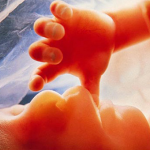Written by Michael Baker
April 27th, 2021—Thursday in Pentecost Week
This article was originally published on the website Super Flumina Babylonis
Disclaimer: “The opinions expressed in the following article, either by the author or those he quotes in the article,
are not necessarily those of Family Life International (Australia) Ltd.”
THE INFINITE DIGNITY OF THE PERSON
An answer to Roberto de Mattei
“Everything comes to an end… we pass from one thing to another until at last we arrive at eternity.
Even seeing how the things of this life end so quickly ought to console us,
because the nearer and more quickly we are approaching that end towards which all our activities should tend.”
St Teresa Margaret of the Sacred Heart[1]
One of Australia’s abiding mysteries concerns the identity of a man found dead on a South Australian beach in the Adelaide suburb of Somerton on December 1st, 1948. Nothing is known of his background or country of birth. Even the cause of his death is unknown. Around the time he died a copy of a book featuring the Rubaiyat of Omar Khayyam (translated by Edward Fitzgerald), much in vogue at the time, was found tossed through the open window of a doctor’s car in nearby Glenelg. In it was inscribed the telephone number of an Adelaide nurse, Jo Thomson. The relevance of this finding lies in the fact that a scrap torn from the same book, bearing the Persian words, Tamam Shud (‘it is finished’), was found in one of the dead man’s pockets. The granddaughter of the Adelaide nurse believes she may be descended from him. This has led to the exhumation of the man’s remains in the hope that modern DNA technology may shed light on the mystery. The exhumation occurred just the other day.

Here is an extract of journalist David Penberthy’s account in The Australian of May 20th, 2021:
“The process by which The Somerton Man was exhumed was deeply respectful and spearheaded by one of SA’s most senior police officers, veteran Detective Superintendent Des Bray…
“Care was taken at West Terrace Cemetery to maintain The Somerton Man’s privacy… Superintendent Bray said it was important the exhumation was being done with dignity and respect. ‘The Somerton Man is not just a curiosity or a mystery to be solved. He’s somebody’s father, son, perhaps grandfather, uncle, brother…’”
No one would take exception to the sentiments expressed. It is what we would expect in any action concerning the dead body of any man. Isn’t it?
_______________________
Man’s dignity lies in his creation in the image and likeness of God, with intellect and will. The Catholic Church holds that, since it is a spiritual reality, the human soul must be infused by God at the very moment of conception; it cannot result from the merely physical act of generation. Body and soul comprise one substance, or suppositum, and, though he be dead, a man’s body must be treated with the respect due to a creature who is like God in this, too, that he will live forever.
The society in which we live is atheist, and schizophrenic. It lives in perpetual denial of the supreme principle of logic, the principle of non-contradiction. We are, all of us, infected willy-nilly with the dysfunction schizophrenia names. Only this can account for the blindness among even the most orthodox of Catholics over the cooperation in evil entailed in the use by scientists of elements derived from the bodies of aborted infants to aid the health of others. Why are we incapable of seeing the murdered child as someone’s son or daughter; someone’s brother or sister; one who might have been a father or mother, uncle or aunt, grandfather or grandmother—like the Somerton man—had not the selfishness and hatred endemic to the age intervened? Why do we have so little regard for the unborn child, who will live for all eternity, as to treat his body as a means to aid, we hope, our transient earthly comfort?
Dr Roberto de Mattei’s study on the covid 19 vaccines On the Moral Liceity of the Vaccination[2] in pdf format runs to 75 pages. They are 75 pages of special pleading. That the author is in doubt about the cogency of his argument, despite its length, appears in its last paragraphs where he appeals to a Church ruling of the 17th century to assert that if the contention of moral liceity of vaccination [with a tainted vaccine] was only a probable opinion, it would be licit to follow it. He mistakes a number of principles.
1. There is not one evil at stake in this debate; there are two. The first evil is the murder of the unborn child. The second is the abuse of the child’s body by taking from it elements to enhance the efficacy of a vaccine. Of these two evils only the second is in issue. The first is irrelevant per se because it is past. The second evil is present, and continuing, as long as the vaccine remains in use. There can be no cooperation in an evil that is past. There can be cooperation—proximate, material cooperation—in an evil that is present. That is the issue
He is in error, then, when he poses as the question to be addressed: Does the receipt of, or if I am a doctor, the injection of [tainted] vaccines, render me complicit in abortion? The question is this: Does the receipt of, or if I am a doctor, the injection of [tainted] vaccines, render me complicit in the present moral evil of abuse of the body of an aborted child?
2. The common good of society is not named ‘common’ by reason of commonality of genus or species, but of finality (Summa Theologiae I-II, q. 90, a. 2, ad 3). That is, it has to do with man’s ultimate end. Man is imperfect as an individual which is why he needs society. But society does not exist for its own sake. It exists to serve man the person, for man, as person, is perfect: an end in himself.[3] Thus, man’s nature and end specify the common good which—
- is natural—not something of human will (voluntary)—the increment that accrues naturally on man’s living in society;[4] it does not derive from any ‘social contract’.
- is immaterial, a good of order, in which all members of society share, and it suffers no diminution in being shared.
- is not to be confused with public goods (buildings, roads, infrastructure etc., which serve the public good); nor with the public good (government, legislature, judiciary, etc.), whose raison d’être it is to foster and promote the common good.
- has nothing to do with the individual goods of society’s members taken individually or collectively, their wealth or health, save incidentally, as detailed below; a pauper shares in it equally with one who is well-off; the sick man shares in it equally with the healthy.
- is a good greater than that of any individual. (II-II, q. 47, a. 10)
The principal end the common good respects is man’s union with God in heaven, for that is man’s ultimate end. To this end all other ends that may arise in society are subordinate. It is grounded in charity which is the chief source of order among men (I, q. 96, a. 4), and in general justice, which has the common good as its proper object (II-II, q. 58, a. 6). For a succinct expression of what the common good is, read the words of the Carmelite saint in the epigraph.
In a subsidiary manner—but only as they serve its principal end—does the common good centre on the present ends of human existence, happiness in family life, social interaction, peaceful work and recreation, the health and wealth of its members. It is not to be reduced to what those governing society may consider necessary for the good of society if this ignores man’s ultimate end. The health of the individual impinges on the common good only insofar as its possession conduces to that end. A man’s health is of little account when, to save the common good, the state requires him to put his life at risk in defence of his country! The five bishops led by Janis Cardinal Pujats put it well in their December 2020 statement, The End cannot justify the Means: “bodily health is not an absolute value”.[5]
The common good is harmed fundamentally by the murder of just one innocent child because this betrays its principal end.[6] That harm increases with any act that serves to condone in no matter how slight a fashion the child’s murder. It is a moral, and logical, contradiction to appeal to the common good to justify action to protect the health of society’s members when the action itself attacks the common good.[7] Hence, the use of a vaccine that depends for its efficacy on elements taken from the body of a murdered child is morally illicit.
3. No one may treat the human body, even after death, as one treats any merely material thing. In his arguments Professor de Mattei reduces the body of the murdered child to the level of a mere thing, a useful good—bonum utile.[8] In doing so he effectively denies the child’s infinite dignity. The principle at stake was one about which Pius XII warned repeatedly in his Addresses to medical practitioners in the 1950s.
4. What is entailed in the action of the scientist who uses the body of a child for some material advantage is theft of the child’s organs.[9] In dismissing this breach of justice as peripheral to the issue of the murder of the child Professor de Mattei shows that he fails to see that the issue at stake is not the child’s murder, but the evil of the abuse of his body afterwards.[10]
In fairness to him, Professor de Mattei gets some things right, as when he says:
“[I]f the use of cell lines deriving from aborted foetuses is in itself intrinsically illicit, this includes not merely the anti-Covid vaccine(s), but all viral vaccines commonly in use” such as vaccines against rubella, chickenpox, poliomyelitis and hepatitis A.
And:
“If… the imposition of [a] vaccination was itself immoral, citizens would not only have a right, but a moral duty, to risk not only dismissal, but even death, to avoid submitting to it.”
But these hardly balance his errors, the more egregious of which are the following.
A. The assertion of legitimacy of the vaccine, as of its usage, cannot survive the conditions of the Principle of the Double Effect. I have dealt with this elsewhere,[11] but shortly stated, the act of vaccination is not a natural act (which is good per se) but an artificial one, and takes its morality from the end it seeks to serve—the preservation of the subject’s health, allegedly. But this is compromised if the vaccine taken offends the common good. Vaccination with such a vaccine cannot, therefore, be regarded as a morally neutral act. There are four conditions. If one fails, as this, the first of the four does, one need look no further. The act is illicit.
B. The Congregation for the Doctrine of the Faith (CDF) has demonstrated its incompetence in moral matters repeatedly over the last 30 years, notably in its inability to offer a moral solution to the issue of artificially preserved human embryos. This incompetence reflects the division in the Church to which Archbishop Viganò referred in an Address in October 2020:
“For sixty years, we have witnessed the eclipse of the true Church by an anti-church that has progressively appropriated her name, occupied the Roman Curia and her Dicasteries, Dioceses and Parishes, Seminaries and Universities, Convents and Monasteries. The anti-church has usurped her authority, and its ministers wear her sacred garments; it uses her prestige and power to appropriate her treasures, assets, and finances.”[12]
One cannot trust any directive that issues from the Vatican as emanating from Christ’s Church. Its reliability can only be discerned by weighing what it has to say against the Church’s constant teaching. Professor de Mattei seems to acknowledge this, but later contradicts himself by appealing to its authority.
It is a lamentable situation that the Church has currently no authoritative body to rule finally on complex moral issues. The last Pope of the Catholic Church who was a moral theologian was Pius XII and he died more than 60 years ago.
C. The assertion that the facts surrounding the 1972 Andes plane crash provide justification for his thesis cannot stand. The cannibalistic behaviour of the plane’s occupants may be excusable; it cannot be justified morally. What strikes the reader of the history of the events of this disaster is the absence, in people from a Catholic country, of any sense of collective thanksgiving to God for their deliverance, or of need for collective recourse to Him to see them safely returned to homes and loved ones. Their rescue was not impossible: search aircraft flew over the site several times in the days that followed the crash. A good argument can be mounted that the position in which they found themselves resulted from their refusal to acknowledge their utter dependence on God in their need. Let the reader consider the force of Psalm 106.[13] One who objects to this view might consider Numa Turcatti, one of their number, who chose to die rather than eat human flesh. Was his no more than a quixotic gesture; or was it, rather, an exercise in heroism by one who refused to breach the moral law?
D. Nor can his thesis be justified by appealing to the solution of the dilemma faced by surgeon, Dr Susan Mackinnon, in using anatomical drawings of the Nazi surgeon, Eduard Pernkopf—tainted in their provenance—to assist a critical element of her surgery. The attempt by the Catholic moralists cited by Professor de Mattei to treat material derived from aborted children on analogy with the tainted drawings is flawed; the cases differ in mode of causality. In the case of surgery, the surgeon is an efficient cause and therefore extrinsic to the work performed.[14] The drawing to which the surgeon had recourse served as instrument in her task and its influence on the effect, reflecting that of the principal, was that of instrumental efficient cause.[15] The taint of its provenance was, accordingly, accidental to the work. In the case of vaccination however, a tainted vaccine involves formal causality which is intrinsic to the work performed.[16] The vaccine relies for its vigour on elements of the aborted child’s body which are essential to its effectiveness. The taint affects both vaccine and vaccination.

Numa Turcatti
30.10.1947 – 11.12.1972
E. Nor can it be justified by appealing to the well-known teaching of St Paul on eating food sacrificed to idols. There was no evil in the food to be eaten—the only evil lay in the possibility of scandal to those ignorant of the principle involved.
F. Nor by general appeal to Christ’s teaching that nothing entering into a man can defile him. Our Lord was using hyperbole to make a point, which was that evil intentions come from within the human heart. If Christ’s words were taken literally it would mean that no poison ingested could kill a man, which is nonsense.
G. The Professor’s citation of the Bishop of Spokane, Thomas Daly, as providing a “balanced exposition of the doctrine of the Church on the use of vaccines derived from aborted foetuses” (his footnote 59), contradicts his earlier position. For the good bishop relies on rulings of the CDF which turn on the false premise that the use of a tainted vaccine is remote material cooperation in a past act. His Lordship goes on to invite his readers to consider the common good of society when the good to which he is referring is not the common good at all, only part of society’s public goods.
Conclusion
The impression one gains from reading his work is that Professor de Mattei first formed a view about the issue then went looking for reasons to support it. This is the approach of the subjectivist; it is not that of the realist who, emulating Aristotle, looks at reality and conforms his view to what reality reveals to him. The root problem in his approach is lack of a comprehensive grasp of metaphysical principle. It is not enough to have some metaphysics; you have to have the science thoroughly.[17] One who demonstrates such a grasp in the present debate, is Don Pietro Leone in his paper Chains of Evil.[18]
I find it remarkable that Professor de Mattei should treat so off-handedly the formal pronouncement on so serious a topic by five bishops of the Catholic Church, known for their orthodoxy, and consonant with the Church’s constant teaching. The Professor was not consecrated a successor of the Apostles and teacher of the faithful. Why does he think he is free to gainsay their considered opinion? Is it because other bishops, more doubtful in their orthodoxy, take a different view?
The writer’s experience in discussions with fellow Catholics is that the sensus fidelium on this grave moral issue is more likely to be found among the lowly faithful than among the ‘experts’. The sense of revulsion they exhibit is well exemplified in the spontaneous rejection of the position of Professor de Mattei by his English/Italian translator, Francesca Romana,[19] in early April. I recommend her paper to the reader.
In the abiding world situation where the dominant religion,[20] atheism, calls the shots on moral matters, the proper position of the Catholic Church is to issue a formal ruling, binding under pain of sin, directing that no member of the faithful may licitly take a vaccine that relies in its provenance on cells or elements derived from the bodies of aborted babies for any reason whatsoever. The teaching function of such a ruling, added to its coercive power, would have far more effect in dampening the operations of drug companies, scientists, doctors and those who engage in the intrinsic evil of abortion, than any action currently being taken.








